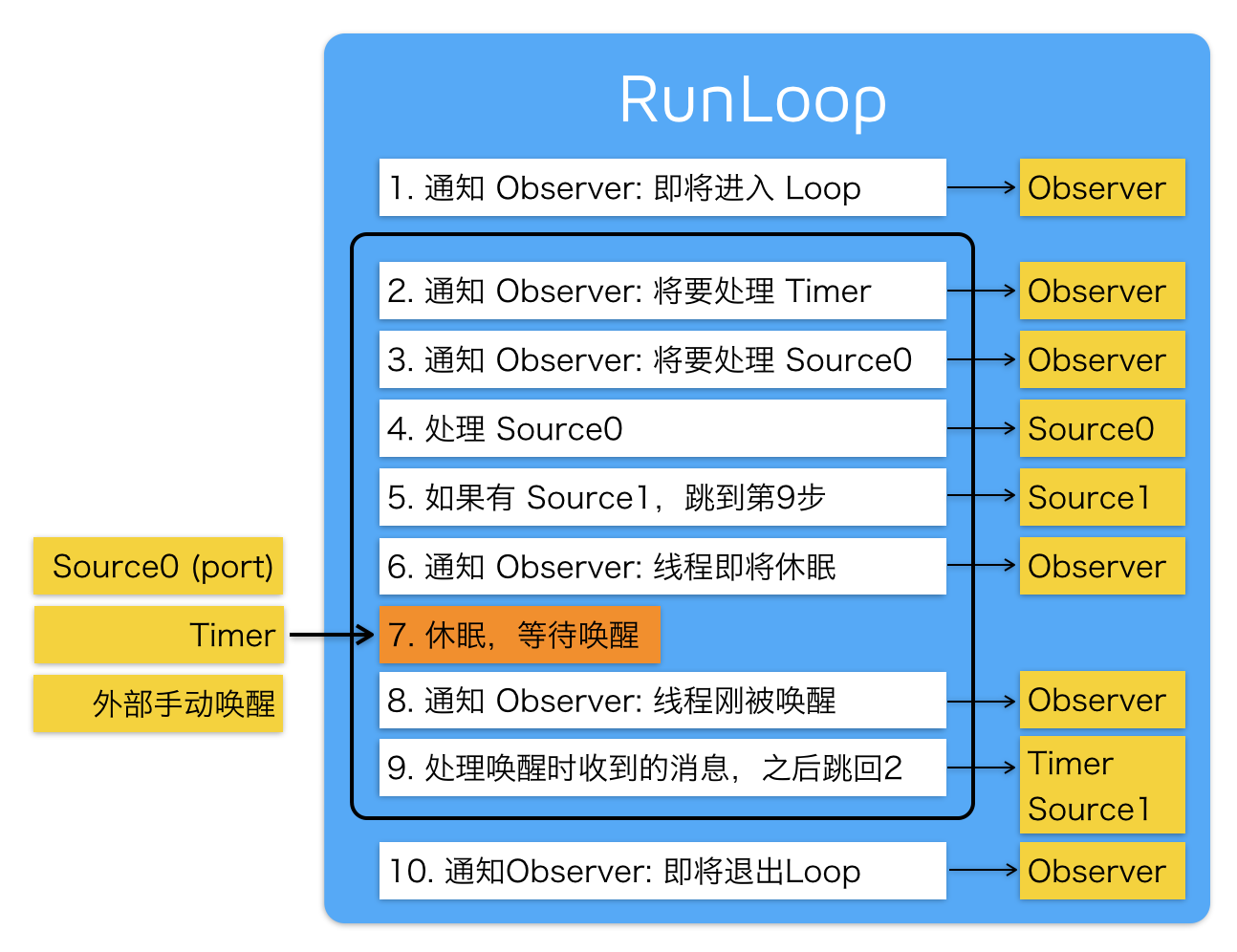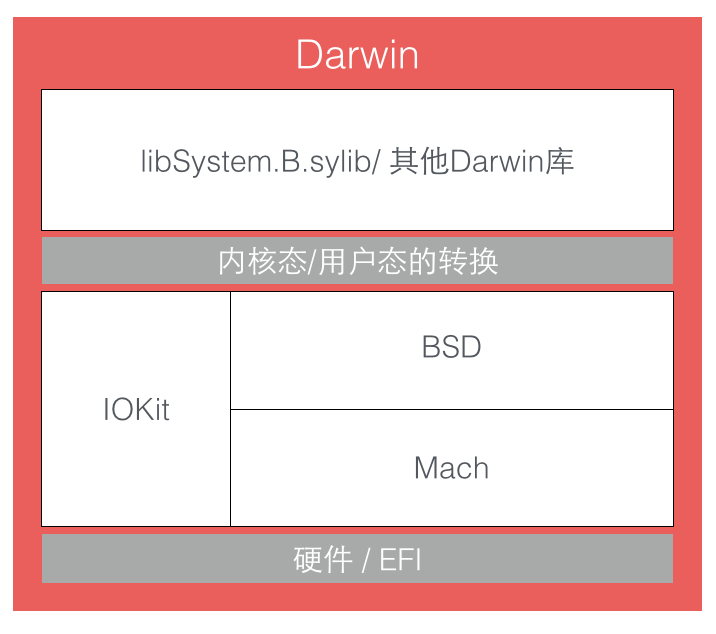原文链接:http://yangchao0033.github.io/blog/2016/01/07/runloopshen-du-tan-jiu-(er-)/
RunLoop 的内部逻辑
根据苹果在文档里的说明,RunLoop 内部的逻辑大致如下:
 内部逻辑
内部逻辑
内部代码整理为:
/// 用DefaultMode启动
void CFRunLoopRun(void) {
CFRunLoopRunSpecific(CFRunLoopGetCurrent(), kCFRunLoopDefaultMode, 1.0e10, false);
}
/// 用指定的Mode启动,允许设置RunLoop超时时间
int CFRunLoopRunInMode(CFStringRef modeName, CFTimeInterval seconds, Boolean stopAfterHandle) {
return CFRunLoopRunSpecific(CFRunLoopGetCurrent(), modeName, seconds, returnAfterSourceHandled);
}
/// RunLoop的实现
int CFRunLoopRunSpecific(runloop, modeName, seconds, stopAfterHandle) {
/// 首先根据modeName找到对应mode
CFRunLoopModeRef currentMode = __CFRunLoopFindMode(runloop, modeName, false);
/// 如果mode里没有source/timer/observer, 直接返回。
if (__CFRunLoopModeIsEmpty(currentMode)) return;
/// 1. 通知 Observers: RunLoop 即将进入 loop。
__CFRunLoopDoObservers(runloop, currentMode, kCFRunLoopEntry);
/// 内部函数,进入loop
__CFRunLoopRun(runloop, currentMode, seconds, returnAfterSourceHandled) {
Boolean sourceHandledThisLoop = NO;
int retVal = 0;
do {
/// 2. 通知 Observers: RunLoop 即将触发 Timer 回调。
__CFRunLoopDoObservers(runloop, currentMode, kCFRunLoopBeforeTimers);
/// 3. 通知 Observers: RunLoop 即将触发 Source0 (非port) 回调。
__CFRunLoopDoObservers(runloop, currentMode, kCFRunLoopBeforeSources);
/// 执行被加入的block
__CFRunLoopDoBlocks(runloop, currentMode);
/// 4. RunLoop 触发 Source0 (非port) 回调。
sourceHandledThisLoop = __CFRunLoopDoSources0(runloop, currentMode, stopAfterHandle);
/// 执行被加入的block
__CFRunLoopDoBlocks(runloop, currentMode);
/// 5. 如果有 Source1 (基于port) 处于 ready 状态,直接处理这个 Source1 然后跳转去处理消息。
if (__Source0DidDispatchPortLastTime) {
Boolean hasMsg = __CFRunLoopServiceMachPort(dispatchPort, &msg)
if (hasMsg) goto handle_msg;
}
/// 通知 Observers: RunLoop 的线程即将进入休眠(sleep)。
if (!sourceHandledThisLoop) {
__CFRunLoopDoObservers(runloop, currentMode, kCFRunLoopBeforeWaiting);
}
/// 7. 调用 mach_msg 等待接受 mach_port 的消息。线程将进入休眠, 直到被下面某一个事件唤醒。
/// • 一个基于 port 的Source 的事件。
/// • 一个 Timer 到时间了
/// • RunLoop 自身的超时时间到了
/// • 被其他什么调用者手动唤醒
__CFRunLoopServiceMachPort(waitSet, &msg, sizeof(msg_buffer), &livePort) {
mach_msg(msg, MACH_RCV_MSG, port); // thread wait for receive msg
}
/// 8. 通知 Observers: RunLoop 的线程刚刚被唤醒了。
__CFRunLoopDoObservers(runloop, currentMode, kCFRunLoopAfterWaiting);
/// 收到消息,处理消息。
handle_msg:
/// 9.1 如果一个 Timer 到时间了,触发这个Timer的回调。
if (msg_is_timer) {
__CFRunLoopDoTimers(runloop, currentMode, mach_absolute_time())
}
/// 9.2 如果有dispatch到main_queue的block,执行block。
else if (msg_is_dispatch) {
__CFRUNLOOP_IS_SERVICING_THE_MAIN_DISPATCH_QUEUE__(msg);
}
/// 9.3 如果一个 Source1 (基于port) 发出事件了,处理这个事件
else {
CFRunLoopSourceRef source1 = __CFRunLoopModeFindSourceForMachPort(runloop, currentMode, livePort);
sourceHandledThisLoop = __CFRunLoopDoSource1(runloop, currentMode, source1, msg);
if (sourceHandledThisLoop) {
mach_msg(reply, MACH_SEND_MSG, reply);
}
}
/// 执行加入到Loop的block
__CFRunLoopDoBlocks(runloop, currentMode);
if (sourceHandledThisLoop && stopAfterHandle) {
/// 进入loop时参数说处理完事件就返回。
retVal = kCFRunLoopRunHandledSource;
} else if (timeout) {
/// 超出传入参数标记的超时时间了
retVal = kCFRunLoopRunTimedOut;
} else if (__CFRunLoopIsStopped(runloop)) {
/// 被外部调用者强制停止了
retVal = kCFRunLoopRunStopped;
} else if (__CFRunLoopModeIsEmpty(runloop, currentMode)) {
/// source/timer/observer一个都没有了
retVal = kCFRunLoopRunFinished;
}
/// 如果没超时,mode里没空,loop也没被停止,那继续loop。
} while (retVal == 0);
}
/// 10. 通知 Observers: RunLoop 即将退出。
__CFRunLoopDoObservers(rl, currentMode, kCFRunLoopExit);
}
可以看到,实际上 RunLoop 就是这样一个函数,其内部是一个 do-while 循环。当你调用 CFRunLoopRun() 时,线程就会一直停留在这个循环里;直到超时或被手动停止,该函数才会返回
RunLoop 的底层实现
从上面代码可以看到,RunLoop 的核心是基于 mach port 的,其进入休眠时调用的函数是 mach_msg()。为了解释这个逻辑,下面稍微介绍一下 OSX/iOS 的系统架构。
 底层逻辑
底层逻辑
苹果官方将整个系统大致划分为上述4个层次:
应用层包括用户能接触到的图形应用,例如 Spotlight、Aqua、SpringBoard 等。
应用框架层即开发人员接触到的 Cocoa 等框架。
核心框架层包括各种核心框架、OpenGL 等内容。
Darwin 即操作系统的核心,包括系统内核、驱动、Shell 等内容,这一层是开源的,其所有源码都可以在 opensource.apple.com 里找到。
我们在深入看一下 Darwin 这个核心的架构
 Darwin
Darwin
其中,在硬件层上面的三个组成部分:Mach、BSD、IOKit (还包括一些上面没标注的内容),共同组成了 XNU 内核。
XNU 内核的内环被称作 Mach,其作为一个微内核,仅提供了诸如处理器调度、IPC (进程间通信)等非常少量的基础服务。
BSD 层可以看作围绕 Mach 层的一个外环,其提供了诸如进程管理、文件系统和网络等功能。
IOKit 层是为设备驱动提供了一个面向对象(C++)的一个框架。
Mach 本身提供的 API 非常有限,而且苹果也不鼓励使用 Mach 的 API,但是这些API非常基础,如果没有这些API的话,其他任何工作都无法实施。在 Mach 中,所有的东西都是通过自己的对象实现的,进程、线程和虚拟内存都被称为"对象"。和其他架构不同, Mach 的对象间不能直接调用,只能通过消息传递的方式实现对象间的通信。"消息"是 Mach 中最基础的概念,消息在两个端口 (port) 之间传递,这就是 Mach 的 IPC (进程间通信) 的核心。
Mach 的消息定义是在 <mach/message.h> 头文件的,很简单:
typedef struct {
mach_msg_header_t header;
mach_msg_body_t body;
} mach_msg_base_t;
typedef struct {
mach_msg_bits_t msgh_bits;
mach_msg_size_t msgh_size;
mach_port_t msgh_remote_port;
mach_port_t msgh_local_port;
mach_port_name_t msgh_voucher_port;
mach_msg_id_t msgh_id;
} mach_msg_header_t;
一条 Mach 消息实际上就是一个二进制数据包 (BLOB),其头部定义了当前端口 local_port 和目标端口 remote_port,
发送和接受消息是通过同一个 API 进行的,其 option 标记了消息传递的方向:
mach_msg_return_t mach_msg(
mach_msg_header_t *msg,
mach_msg_option_t option,
mach_msg_size_t send_size,
mach_msg_size_t rcv_size,
mach_port_name_t rcv_name,
mach_msg_timeout_t timeout,
mach_port_name_t notify);
为了实现消息的发送和接收,mach_msg() 函数实际上是调用了一个 Mach 陷阱 (trap),即函数mach_msg_trap(),陷阱这个概念在 Mach 中等同于系统调用。当你在用户态调用 mach_msg_trap() 时会触发陷阱机制,切换到内核态;内核态中内核实现的 mach_msg() 函数会完成实际的工作,如下图:
 Darwin
Darwin
这些概念可以参考维基百科:System_call、Trap_(computing)
RunLoop 的核心就是一个 mach_msg() (见上面代码的第7步),RunLoop 调用这个函数去接收消息,如果没有别人发送 port 消息过来,内核会将线程置于等待状态。例如你在模拟器里跑起一个 iOS 的 App,然后在 App 静止时点击暂停,你会看到主线程调用栈是停留在 mach_msg_trap() 这个地方。
关于具体的如何利用 mach port 发送信息,可以看看 NSHipster 这一篇文章,或者这里的中文翻译 。
关于Mach的历史可以看看这篇很有趣的文章:Mac OS X 背后的故事(三)Mach 之父 Avie Tevanian。
特别致谢:
http://blog.ibireme.com/
2015/05/18/runloop/#more-41710
参考文章:
深入理解RunLoop(ibireme):
http://blog.ibireme.com/
2015/05/18/runloop/#more-41710
Apple Document:
https://developer.apple.com/library/ios/documentation/Cocoa/Conceptual/Multithreading/RunLoopManagement/RunLoopManagement.html
维基百科:
NSHipster:










网友评论